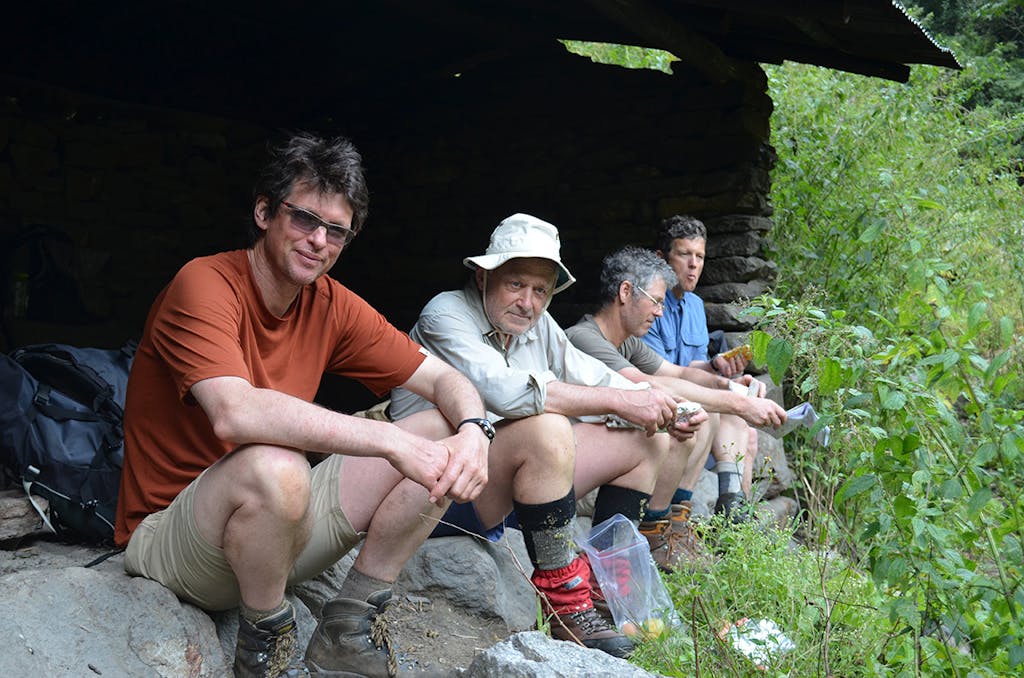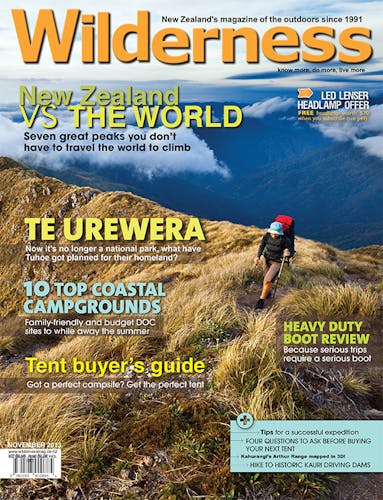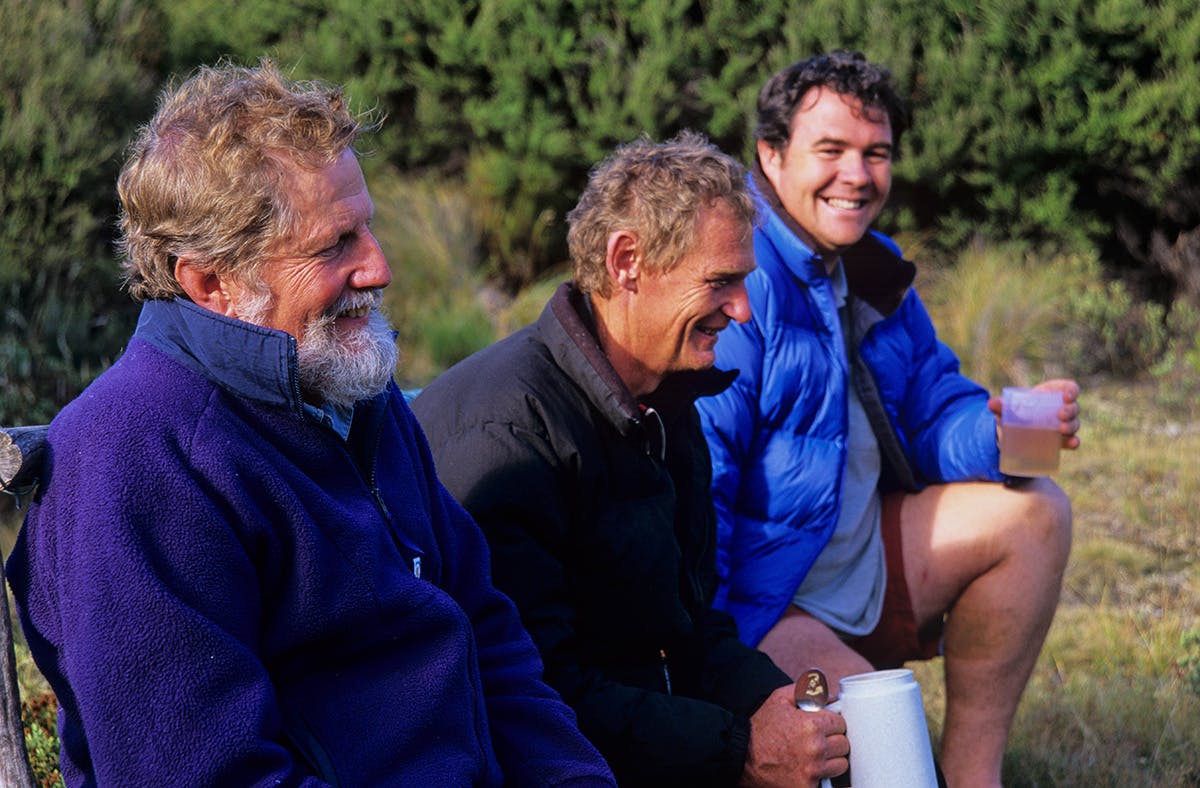Ricky French talks to some tramping legends to find out how times have changed and why the lure of the hills remains even as we become less able to explore them
When I first ventured into the bush I was in my teens and in my element. Fearless and unbreakable, I was prepared to suffer any indignity or hardship for the honour of getting caught in snow-drifts on the tops, or biting my way through a ho-hum blizzard while scaling a wall of ice-coated scree. I would quite happily bask in the novelty of hauling myself up gullies comprised entirely of leatherwood, spaniards, boulders and freezing water. I would run an icy, swollen finger along a map completely devoid of dotted lines, looking for a way out of whatever latest perilous situation I had managed to land myself in. Look mum, no track.
On my feet I wore sand shoes and my first pack was as square as a box, had an external frame and was shared with other family members. When someone else needed it, I wore my school bag. I still remember the proud feeling of owning my first polypropylene skivvy; it was as though I had graduated tramping school and was officially an elder.
We didn’t let excuses get in the way of tramping. One winter’s weekend my friends and I caught the train from Wellington to a slab of concrete station in the western Hawke’s Bay and hitchhiked to the start of the track, intending to cross the Ruahines to Mangaweka. Two days later we were back at that same spot, beaten back by ice and a lack of decent gear (and possibly skill) and we thumbed a lift through the frozen high country on the back of a farm ute loaded to the gunwales with the carcasses of dead lambs that had perished in the cold of the night before. It didn’t occur that it could well have been us.
Now at that grand old age of 33, my boots are soundly waterproof and my pack feels like a hefty pillow. I have even been known to spend more than $15 on a single pair of socks. We rarely choose epic routes, though we often choose cheesecake. Call it comfort tramping. The initiation was completed long ago, why push yourself through the pain barrier when you can choose to lift the barrier with modern toys?
GPS devices, hydration packs, hiking poles (to think we just used to pick up a stick!), water-purification tablets, the deeply-troubling ‘stool tool’; it’s a wonder we ever make it out of the house. In one sense we don’t: the huts are now often more comfortable than our real homes. Gone are the mouldy mattresses and the chaotic, bellowing open fireplaces; in are the gas lines, tanning decks and separate hut-warden quarters.
I wanted to know if my experience was typical of trampers. And how do our expectations of what we seek to get out of the outdoors change as we get older?
Things haven’t changed much for 60 year-old tramper Brian Pickering. At 18 years-old he walked the famous 430km Pennine Way in England, solo. You get the feeling he wouldn’t hesitate in attempting a repeat trip now. “Although I’m a bit slower than I used to be, I’m basically at my peak now,” he says. “I don’t seek out easier tramps, if anything I do harder ones.”
Pickering says the realisation of aging has spurred him on to greater things: “My physical abilities will inevitability decline, so I want to do as many hard tramps as I can whilst I still can. I try to push it as much as I can.”
And while Pickering is not planning on taking it easy any time soon, he has begun to smell the roses, so to speak, in his veteran years. “Whenever I am coming to the end of a tramp I intentionally drop back from the group for a few minutes and say ‘goodbye’ to the bush,” he says. “Some evenings after work I will go into the bush with my dog, just to be there.”
Paul Maxim is President of the Tararua Tramping Club and has been stuffing a pack and hitting the hills for more than 30 years. He says that younger trampers are more likely to throw themselves into sticky (or boggy?) situations. “Taking risks in tramping and climbing is far more prevalent in our younger years,” he says. “The heady mix of enthusiasm and fitness can easily propel the ambitious younger tramper and climber to take a risk that more experienced participants are often wary of.”
He reckons as we get older and more settled into life, we become more risk averse. “There’s the issue of dependants,” he says. “A partner in life and particularly children often temper risk-taking, with many climbers choosing not to climb big alpine routes, or severely reducing their acceptable level of risk.”
Maxim is probably on the money there, and it’s true that a few times when I’ve been in difficult situations recently I’ve found myself picturing my five-year-old son back at home, pestering his grandmother and awaiting my return. But what about the matter of comfort; do we also simply desire a less hellish experience out of our wilderness?

Paul Maxim (far left) says he has little desire to repeat the gung-ho trips he did 35 years ago. Photo: Supplied
“With the enthusiasm and energy of youth the prospect of tramping on a Friday night for six hours in the dark of winter was viewed as part of the adventure,” says maxim. “Today, 35 years on, the prospect of repeating such excursions for me holds little appeal.”
So what does now hold appeal to this not-so-young, weather-beaten, tough tramper? “Next time I go to the Tasman Glacier I will fly in, without a moment’s hesitation, and target just one objective. If it’s a winter trip, I’d like to ski out – that sort of thing.
“Perhaps a bit boring for some people.”
When you compare how he tackled trips to the Tasman Glacier when he was younger, it’s obvious to see why his older self is keen to take the easy option. Packs were loaded with eight days of food and were so heavy they had to be rested on something high before you could slip into the straps. The long hike in meant making the most of the time in the mountains, so long climbs, day after day, would be attempted before finally walking out again.
Maxim may sound like a reformed man, but don’t be too sure. “The reasons for pulling the backpack out of the cupboard has not changed a lot,” he says. “The attraction of the mountains and the harmony the outdoors brings to my life remains the same. It is ambition that moulds my enthusiasm.”
Stephen Healey got into tramping from a young age, joining the Wellington Tramping and Mountaineering Club in 1971. He’s still a proud member and tells a familiar tale: “I started tramping in the hills out the back of Tawa when I was 10 or 11. I had a friend a couple of years older and we started with day trips, which became overnight camps and by the age of 12, I was off for my first trip in the local mountain range, the Tararuas.”
Healey speaks passionately about the changes he has seen in tramping over the last 40 years. Gone are the days, when trampers would converge on really wild spots – places, some which I have never heard of but which sound other-worldly and mythical: The Garden of Eden, Olivine Ice Plateau, Bracken Snowfield. Today, some of these places (Healey sites the example of Scone Hut in the Perth River) are likely to be visited by jokers in helicopters, armed with rifles or canoes. The idea of tramping in has almost become quaint.
Healey paints a picture of a time when trampers were resilient and no-nonsense. He remembers when he and his mates routinely took to the tops with no regard to the weather, having to “sidle down the leeward side of a spur to the bush edge to escape winds that were blowing the roofs off houses in the towns below, or battling through thigh-deep snow to reach a hut.”
They also did tough things like sing songs. “I still have a printed songbook,” says Healey. “Clubs used to print books with the lyrics to popular songs and sell them to members. I have great memories of 30 or 40 people gathered around a raging fire, all singing. That’s something that has gone now.”
So besides having to adjust to a new world order, what else has changed in the mindset for a guru such as Healey? “In my early years I would push on in any conditions and complete every trip. Over the last decade or so I’m more interested in the enjoyment and less focussed on the completion.
“If there is a way of amending a trip now to avoid the worst of the weather I would always consider that option. My trips now are just as challenging, but I limit the duration to a week, rather than two weeks.”
Much of tramping-lore is built around storytelling. The songbooks may have disappeared but the constant reminiscing of past tramps will always fill the night air in huts all around the country. Young trampers, old trampers, shy trampers, bold trampers; all have tramping tales to rattle off to rapt ears. Trampers like Healey, Maxim and Pickering are the most valuable resource we have for understanding and appreciating our outdoor history. Knowing where we’re going is good, but it helps to know where we’ve been.
In the remarkable book Shelter From the Storm, Wilderness’ roving editor Shaun Barnett talks of huts being ‘a depository of backcountry knowledge’. But hut books, names carved into walls, rusted tools and battered fireplaces only tell half the story. We need our huts filled with the icy breath of elders, telling us about lumpy, square packs with leather straps, old PVC and japara parkas that stood up by themselves when cold, boots that rubbed feet raw.
These stories leave the hut in the morning with the last bang of the door, to be kept by the lucky. Maps and guidebooks are useful but what about the horse’s mouth? Before saddling up I will always seek the advice of someone who has literally walked the walk. These words keep us safe and keep us grounded.
So what if we slow down a bit and our knees don’t bend quite the way they used to as we get older? Let’s not lose sight of the grand view.
“I still tramp for the same reasons I always have: the thrill and excitement of new vistas in the mountains and that incredible feeling you get on a fine day standing on top of mountain ranges, looking at a myriad of peaks and valleys opening up before you,” says Healey. “To sit camped upon the range tops, watching the evening light weave its magic is just a joyous thing. I intend to keep doing this for many years to come.”
Long may we all.








